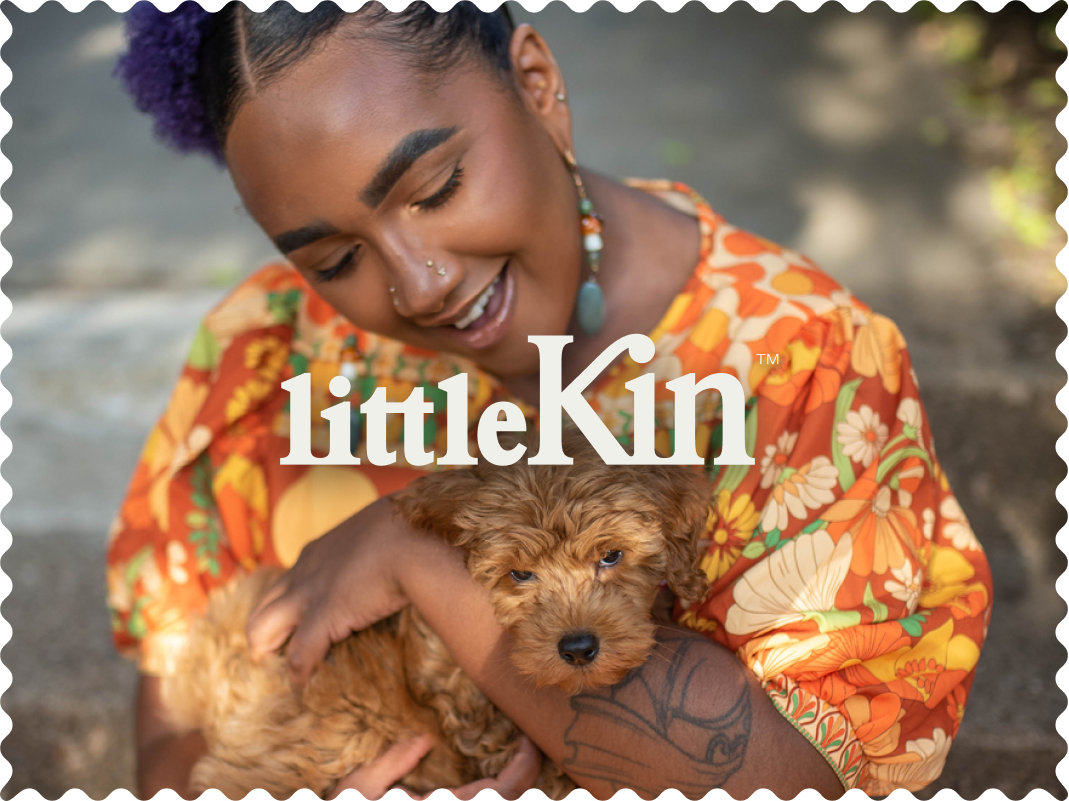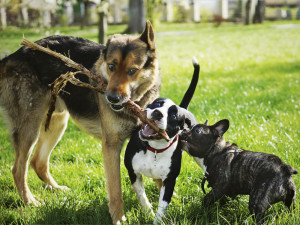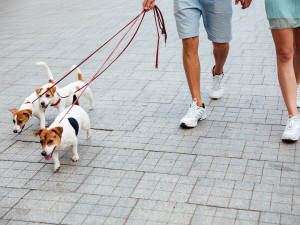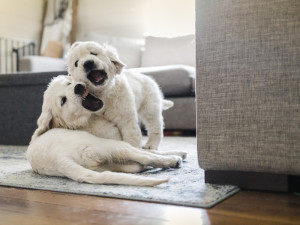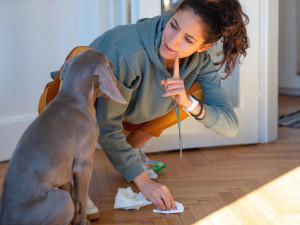8 Things No One Warned You About Having Multiple Dogs
Double (or triple) dog problems... and how to fix them
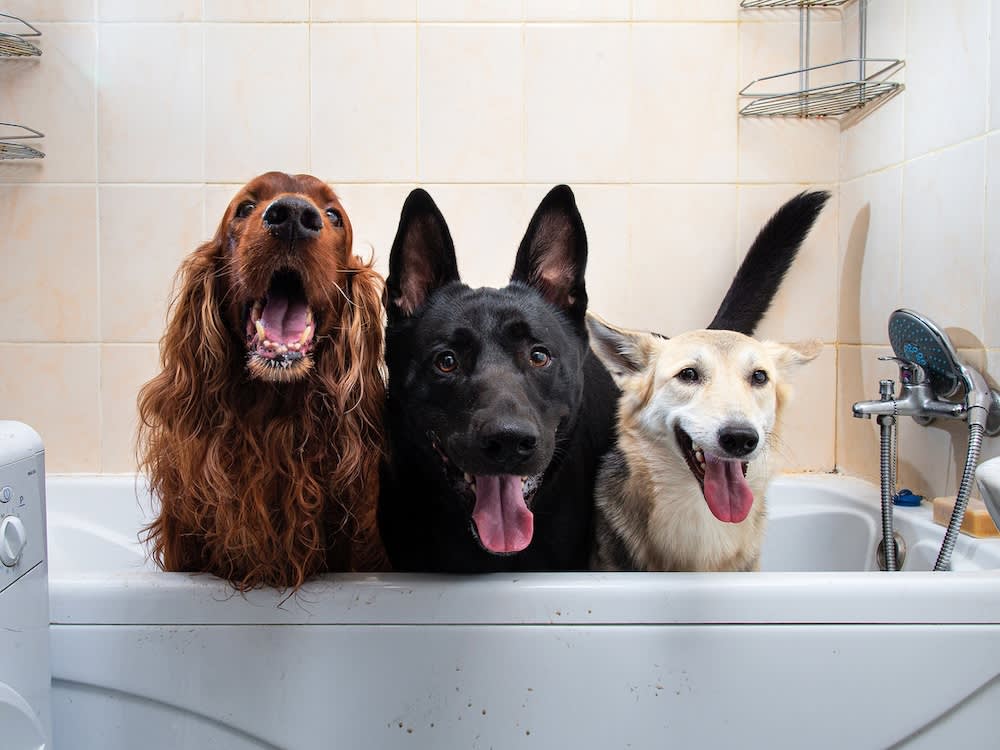
Share Article
Living in a multi-dog household can be a rewarding experience for both the humans and dogs sharing their home together. According to the PDSAopens in new tab, 24% of UK dog parents share their home with more than one dog. There are plenty of multiple dog benefits such as the companionship and connection each dog provides each other, as well as their human family members. But, if you’re considering adding another dog into your family unit, it’s important to be aware that managing multiple dogs is not always smooth sailing.
Watching dogs bond, play and support one another can provide us with a lot of joy. Knowing your dogs have each other’s company can ease guilt when life is busier and you have less time to spend with them. However, the reality of life with more than one dog involves a fair amount more work than just having a single dog in your home. You’ll need to manage different personalities, balance your attention between the dogs, address potential conflicts, and cover increased costs that come with more than one dog. People are often put off bringing littermates into their home due to the challenge of multi-dog bonding, where the dogs may bond better with each other than with their humans. But there’s the opposite problem, too – when some dogs just don’t get on to start with.
While multiple dog ownership offers amplified benefits of living alongside these incredible animals, it can also demand a whole lot of time, patience and commitment to ensure all your individual dogs thrive.
Resource guarding and food aggression
One of the most common challenges when living in a multi-dog household is that of resource guarding and dog food aggression. Resource guarding relates to a dog protecting something that’s important to them from other dogs or humans. These resources can range from food, to toys, physical space, or you – their favourite human. If left unaddressed, dog resource guarding behaviour can lead to serious conflict between dogs. It’s essential to recognise the early signs of guarding and take proactive steps.
Resource guarding typically begins with subtle body language. Watch your dogs for stiff body posture, freezing or hovering over food/toys, growling or side-eye glances when another dog approaches them. In more severe cases, this can escalate to lunging, snapping or biting – especially around high-value food or favourite sleeping spots.
If you have your dogs from a young age, start early by fostering healthy relationships between each dog. Teach puppies that human and canine proximity to food and toys is positive, not threatening. Keep valuable resources (such as chews or toys) distributed to minimise competition – a dog is less likely to guard 10 items than just one.
Follow these simple multi-dog household tips to avoid any escalation of the behaviour.
Monitor body language: watch for early signs of tension, intervene calmly and create space between dogs before things escalate.
Management: feed your dogs in different rooms. This will help to reduce the feeling of competition while they’re eating, reducing stress. Provide multiple sleeping spots, so there’s always a choice of space.
Slow desensitisation: training exercises can be utilised to help your dogs learn that they’re not a threat to each other. Work with an ethical behaviourist, who is experienced in multi-dog dynamics, to ensure no escalation of aggression occurs.
It’s important to understand that guarding behaviours can be in your dog’s DNA or may have stemmed from early experiences alongside their littermates. Understanding the root causes of dog food aggression and resource guarding helps you to maintain a peaceful, safe environment where all your dogs can thrive - together.
Pack hierarchy and dominance Issues
Although the outdated concept of ‘dominance’ in dog training – where humans were told to assert control over their dogs – has been largely discredited by trainers, veterinarians and behaviourists, a degree of dog pack hierarchy can still naturally occur in relationships between dogs. But it’s not as clear cut as you might think.
In a multi-dog household it’s not uncommon to see one dog ‘win’ in one sort of situation (for example, in a game of tug) and another dog ‘win’ in another (getting attention from guests). Motivations will vary between individual dogs, even if they are of the same breed. Pack dynamics are fascinating to watch, exploring their unique personalities.
The difficulty comes when both dogs want the same thing – and that’s when their resource holding potential (how likely they are to win the item) comes into play. Their success in any given situation will depend on age, health, hormones and how they feel about each other. If a dog feels threatened by the other, feeling they’re unlikely to win, that is when ‘distance creating’ behaviours, including aggression, will be seen.
When looking at dog dominance behaviour it’s important to watch out for bullying – for example, during play if one dog pins the other and doesn’t let them get up. The best sort of interactions are when dogs take it in turns to ‘win’ the game they’re playing.
If you see things escalating between your dogs – rising arousal levels or over-pushy behaviour – it’s important to step in early. Intervening before fights have occurred reduces physical and emotional injury to the dogs – and to yourself.
Teaching your dogs to stop and look towards you when you say a specific word can be a successful way to be able to break up play when you see it heading towards trouble. For puppies and adolescent dogs especially, it can be useful to break up play every few minutes to keep arousal low. Redirect them to sniff for some treats or do a trick for you before they re-start the game.
Lead walking multiple dogs
Walking multiple dogs together has its challenges whether they are on or off the lead. But multi-dog lead training really takes some work to be able to enjoy relaxed on-lead walks. Walking two or more dogs together may result in challenges including: playful behaviour, tangled leads, increased pulling and redirection of reactivity.
When you start your lead training, it’s important to work with all dogs through individual walks. You can’t give multiple dogs your full attention during training and they will be a distraction for each other. It can also be helpful to teach each dog a different side of your body to walk on, so that you can balance the number of leads you eventually have in each hand.
While there are multi-dog leads that utilising couplers, these can cause problems if one dog doesn’t want to move forwards and the other is pulling them along. These can also heighten arousal with the dogs being so close together – and if one dog is inclined to redirect any anxiety they’re feeling onto the other, it�’s less easy to part them. Stick instead to standard 1-2 metre length leads connected to a harness, working on lead training exercises as opposed to relying on equipment to fix any pulling. Multiple dogs can easily pull a person over or put pressure on your joints, so seek help taking those leads if you need it when walking your group of dogs.
Individual attention and bonding
There’s nothing like dog parent guilt to make you feel like you’re failing – and sometimes, living with multiple personalities of dogs can leave you feeling you’re not giving them all enough individual dog attention. It can be especially difficult when one dog was used to being your only dog – your only focus – and then you move other dogs in and need to share your attention around.
To help fulfil all your dogs’ needs, think about what each dog enjoys the most and schedule in time each week to give them a little of what they love. If you have a dog who loves sniffing, you might take them for a walk in a forest or do some scatter feeding on your lawn. For a dog who loves to run, you might take them to an agility class or play a game of ‘catch me if you can’ in your garden. Engaging with each dog by doing something that brings them enjoyment will help solidify your individual bond with them, too.
When it comes to snuggle time on the sofa, make sure those that love to cuddle are all getting some human contact throughout the week. And if your dogs don’t like to share your attention, be clear about who you’re giving focus to at any one time, while letting the other dogs know that their time will come.
Allow your dogs to take the time to bond with each other, too, as that can help take some of the pressure off you as the primary entertainment provider.
Different energy levels and exercise needs
While it may sound like the dream to take long walks with your whole family of dogs, it’s important to understand each of your dog’s individual capabilities. Meeting each dog’s unique exercise needs is essential for their physical and mental health. Too much and you could be putting one of your dogs at risk of injury or emotional overwhelm.
Start by assessing individual energy levels. A younger adult dog will need significantly more exercise than a senior dog or young puppy. Consider age, breed, temperament and health status to evaluate each dog’s requirements.
Not being able to exercise all your dogs together can feel difficult to manage, so try to get creative with your schedule. Stagger walks, looping back to collect a dog that can’t travel as far. Add in enrichment activities for those dogs who need more mental stimulation than physical.
If managing time is really challenging, then having support from a local dog walker might ease the pressure on you as you try to cater for all your dogs’ different activity needs.
Managing energy levels within the home is also important. If you have an older dog who is less inclined to play, then giving them space away from a younger, more persistent player might be beneficial for all – to get good rest and relaxation.
Veterinary care and health management
One area you may not have considered as a bit of a unique challenge is looking after multiple dogs’ health at the same time. Not only is there the financial cost that multi-dog veterinary care entails but also the time perspective of scheduling appointments and making sure all dogs have their physical needs met.
When it comes to vet visits, while it may seem easier to book group visits, some dogs might find it too exciting – or an added stress – to have their canine family member with them. You could consider staggering appointments on the same day, with one person taking a single dog in and then another looking after the rest of the dogs in your car. Or simply book appointments for different days. This will reduce stress and allow your vet to give each dog focused care.
Medication management is also important to avoid any confusion of prescriptions when caring for several dogs. Using a pet health app might help with management or you could create a simple chart to track dosages and medication times for each dog.
When one dog gets sick, it may be necessary to isolate them from your other dogs to avoid any spread of disease, especially in cases of contagious conditions like kennel cough or gastrointestinal infections. Consider where you can quarantine the ill dog - and remember to use separate food bowls and bedding.
Space and territory management
A key part of life with multiple dogs is territory management to reduce potential conflict and maintain peace. Some dogs will find it difficult to share space – and that space might be as simple as not wanting to share a bed or as tricky as not wanting to be in the same room as another dog. Creating clearly defined zones throughout your home can be really useful for dogs who like their own space to hang out.
Within your multi-dog space, designate feeding areas to reduce competition and the guarding of food. Set up crates or beds in various spaces around your home to allow choice of sleeping area, where more anxious dogs can retreat. You may even want to consider assigning specific rooms or gated-off sections of your home for solo time. This prevents tension from building when dogs need a break from the larger group dynamic.
When we think of space, it’s important to consider how valuable it is for each individual dog to get used to spending time alone. Too often, dogs from multi-dog households find it difficult to relax on their own and when they lose a canine companion, they really struggle in the home.
Most importantly, having options to separate your dogs to reduce competition, lower arousal, or simply to promote better rest is key to creating a peaceful environment for all.
Training consistency across multiple dogs
One of the most important aspects of multi-dog training is maintaining consistent dog training approaches for all members of the household. This is both in the consistency of cues you use and any house rules you implement.
Think about when it’s best to train your dogs together as a group, and when to work with them individually. Individual sessions are essential when starting off new behaviours or working to resolve challenges. These one-to-one moments reduce distractions and promote learning. Once each dog has grasped the basics, group training sessions can help your dogs to generalise out the behaviour and allow you to add these new cues into everyday life.
Use the same cues and/or hand signals for each dog to help family members stay consistent. Making sure each dog knows their individual name can be beneficial so you can request behaviours from just one dog at a time. Having a ‘pack’ name might also help, so you can ask all the dogs to do something at the same time, like come in from the garden or wait as you open the front door.
Just like people, dogs learn at different speeds. One dog may pick up a new exercise in a single session, while another might need several days of repetition. And what works as a reward for one dog might not suit another. Some dogs will find food more valuable, for another it might be playtime. So make sure you’re always working with the dog in front of you, to get the most out of your training sessions.
The bottom line: managing a multi-dog household
Achieving multi-dog household harmony is more than just introducing your dogs and hoping for the best. Good management, careful observation and taking time for each member of the family allows for successful multi-dog homes.
Ongoing management ensures stability. Use gates or crates for downtime, especially if one dog needs a break. Supervise playtime – especially high-energy play – to avoid escalation. Avoid resources being freely accessible if any of the dogs find that difficult. And training should be ongoing, with consistency of cues and working on your individual bond with each dog. This helps you manage the group as a whole, even in high-distraction situations.
Be observant of subtle changes. If tension builds – like increased resource guarding, growling or avoidance – it’s time to reassess. Sometimes dynamics shift as dogs age or as new dogs are introduced.
If your dogs are showing continued aggression or anxiety around each other, then seek out the help of an ethical dog behaviourist. Don’t try and go it alone: early intervention can prevent serious issues and help forge a truly successful multiple dogs environment.
By combining individual attention, careful integrations and mindful management, you can help to set the stage for lasting harmony in your multi-dog household.

Caroline Wilkinson
Caroline Wilkinson is a Certified Animal Behaviourist. As the Founder of digital pet coaching service Barket Place, Caroline has a passion for improving connections between human and hound, with a focus on relationships and reduction of stress for canines living in a human world.
Related articles
![2 dogs playing]()
Does Your Dog Have Littermate Syndrome?
If you adopted puppy siblings – and they fight nonstop – you could be dealing with littermate syndrome. Here’s everything you need to know
![Dog laying on the ground guarding toy in mouth]()
How to Get Your Dog to Stop Resource Guarding Their Stuff
If your dog growls when you get near their food or toys, read this right now
![A woman cleaning up pee on the wood floors inside while disciplining a grey puppy with a raised finger of disapproval]()
10 Dog Training Habits You Should Drop Right Now
Training a dog can seem pretty intuitive – until it’s not
![mom and daughter playing with puppy]()
How to Introduce Your New Dog to Your Kids
They’ll always remember their first childhood pet – this intro is just the beginning
![Two pet parents walking three dogs]()
The Benefits of Having Multiple Dogs
Beyond more puppy love and snuggle time
